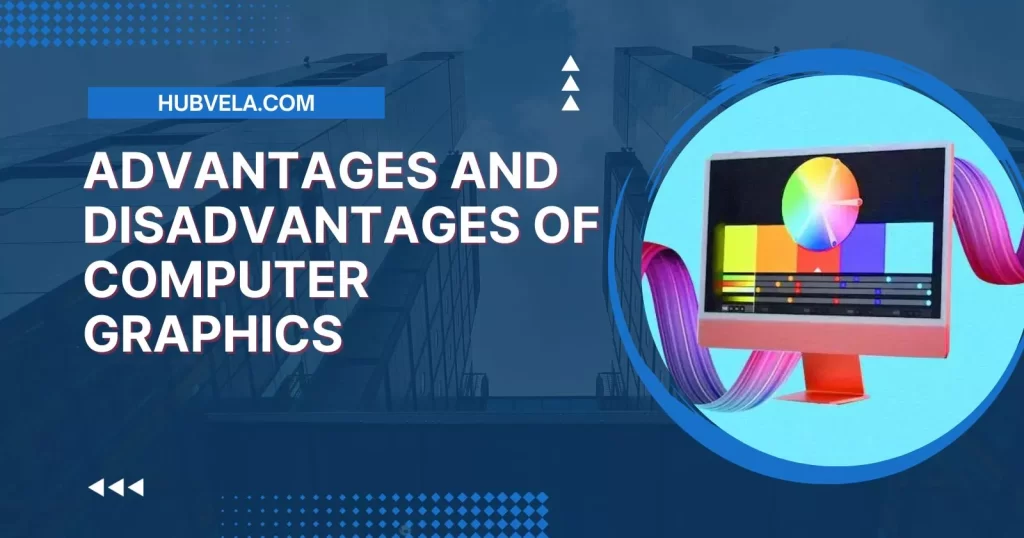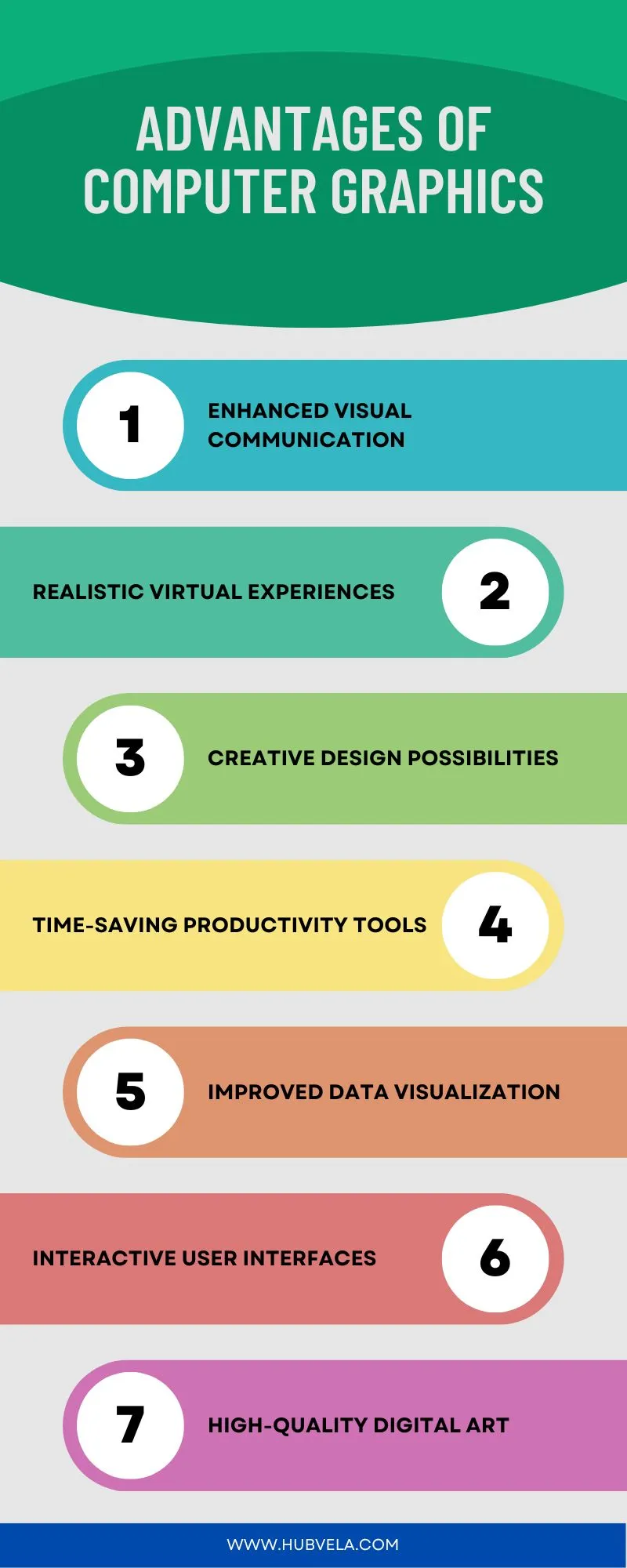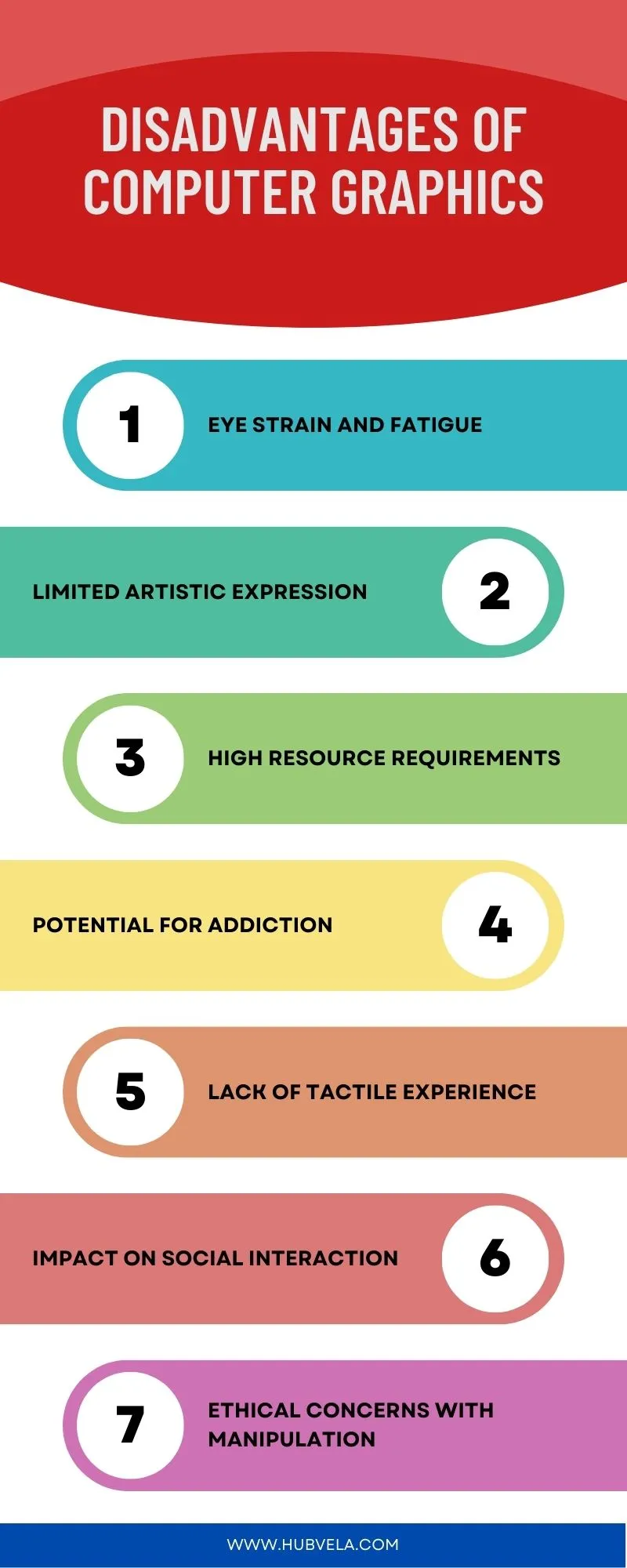Did you know that over 90% of businesses today use computer graphics in some form or another? Computers have revolutionized the way we create and interact with visual content, offering both advantages and disadvantages.
In this article, we will explore the benefits and drawbacks of computer graphics from your perspective. On the positive side, computer graphics enhance visual communication, allowing for realistic virtual experiences and unlocking creative design possibilities. They also provide time-saving productivity tools.
However, there are downsides to consider, such as the lack of tactile experience, the potential impact on social interaction, and ethical concerns regarding manipulation.
By understanding the advantages and disadvantages of computer graphics, you can make more informed decisions about how to leverage this technology in your own life.

--Advertisement--
Advantages of Computer Graphics
Computer graphics, a core technology in digital photography, film, video games, digital art, and more, have revolutionized the way we create and interact with visual content.
The use of computer graphics has numerous advantages, making them an essential tool in various industries and applications. We will explore the benefits of computer graphics.

1. Enhanced Visual Communication
To enhance visual communication, computer graphics provide a powerful tool for conveying information through vivid and interactive visual representations. With the advancement of technology, visual storytelling has become more immersive and engaging.
Virtual reality allows users to step into a virtual world and experience a story firsthand. Multimedia presentations combine various media elements such as graphics, videos, and audio to create a compelling narrative. Animation techniques bring static images to life, making the information more dynamic and easier to understand.
Graphic design plays a crucial role in creating visually appealing and aesthetically pleasing visuals that capture the audience’s attention. By leveraging these advantages of computer graphics, visual communication can be enhanced, resulting in more effective and impactful ways of conveying information.
2. Realistic Virtual Experiences
To fully immerse yourself in realistic virtual experiences, you can take advantage of the power of computer graphics.
Virtual reality (VR) technology, powered by advanced computer graphics, allows you to step into immersive simulations and explore virtual worlds like never before.
With 3D modeling techniques, computer graphics can create lifelike environments and objects, enhancing the realism of virtual experiences.
This is particularly beneficial in gaming experiences, where computer graphics bring characters and landscapes to life, making the gameplay more engaging and captivating.
Additionally, computer graphics play a crucial role in visual storytelling, enabling filmmakers and animators to create stunning visuals that transport viewers to different worlds.
Through the power of computer graphics, realistic virtual experiences are becoming increasingly accessible, revolutionizing the way we entertain, educate, and experience the world around us.
3. Creative Design Possibilities
By harnessing the power of computer graphics, you can unleash a world of creative design possibilities. One of the main advantages of computer graphics is the design flexibility it offers. With the ability to manipulate and modify digital elements, you can create innovative concepts that push the boundaries of traditional design.
Additionally, computer graphics allow for seamless multimedia integration, enabling you to combine various forms of media such as images, videos, and audio to enhance your designs. This integration not only adds depth and complexity to your work but also increases user engagement.
Through visually captivating designs, you can effectively communicate and captivate your audience, utilizing the power of visual storytelling.
4. Time-Saving Productivity Tools
Save time and boost productivity with the efficient tools provided by computer graphics.
With time management being crucial in today’s fast-paced world, computer graphics offer various features that can help you streamline your tasks.
Project collaboration becomes easier as computer graphics allow multiple users to work on the same project simultaneously, eliminating the need for constant back-and-forth communication.
Efficiency gains are achieved through workflow optimization, as computer graphics enable you to automate repetitive tasks and reduce manual effort.
By automating tasks such as rendering or file conversions, you can focus on more important aspects of your work.
5. Improved Data Visualization
With computer graphics, you can easily improve data visualization, allowing you to present information in a more engaging and interactive way. Data analysis becomes more effective when you have graphical representations that help you understand patterns and trends.
Information visualization through computer graphics enables you to present complex data in a simplified and visually appealing manner. The use of graphs, charts, and infographics enhances data interpretation and makes it easier to communicate findings to others.
Visual storytelling becomes possible with computer graphics, as you can create visually compelling narratives that effectively convey the message behind the data. By leveraging the power of computer graphics, you can transform raw data into visually compelling stories that engage and captivate your audience.
6. Interactive User Interfaces
One advantage of computer graphics is that they provide interactive user interfaces. User interaction is crucial in today’s digital world, and computer graphics allow users to engage with the content in a meaningful way. Interactive design plays a vital role in creating user-friendly interfaces that enhance the overall user experience.
Through thoughtful interface design, computer graphics enable users to navigate through the system effortlessly and intuitively. Users can interact with the graphics by clicking, dragging, or zooming in and out, making the experience more immersive and engaging. Moreover, computer graphics offer visual feedback, providing users with immediate responses to their actions. This real-time interaction enhances usability and increases user satisfaction.
7. High-Quality Digital Art
Create stunning digital art with the advantages of computer graphics.
With the advancements in technology, digital painting, graphic design, and other forms of high-quality digital art have become more accessible and versatile. Computer-generated imagery (CGI) allows artists to create realistic and detailed visuals that were once only possible through traditional mediums.
The use of 3D modeling and animation techniques further enhances the possibilities for creating immersive and visually captivating artwork. Computer graphics provide artists with a wide range of tools and effects that can be used to bring their imaginations to life.
Whether you’re a professional artist or an enthusiast, the advantages of computer graphics open up a world of possibilities for creating breathtaking digital art.
Disadvantages of Computer Graphics
Computer graphics have revolutionized various industries, including drug research, automobile manufacturing, and advertising, by enabling the creation of high-quality visual content and facilitating complex design processes.
However, despite their numerous advantages, computer graphics also come with some disadvantages that can hinder their effectiveness and impact. We will discuss the disadvantages of computer graphics.

1. Eye Strain and Fatigue
Excessive exposure to computer graphics can cause eye strain and fatigue for you. This is often referred to as computer vision syndrome (CVS). Spending long hours staring at a screen can strain your eyes, leading to discomfort, dryness, and even headaches.
One of the main culprits behind eye strain is the blue light emitted by computer screens. This high-energy light can disrupt your sleep patterns and cause eye fatigue. Additionally, excessive screen time can contribute to digital fatigue, which can further exacerbate eye strain.
To reduce the risk, it’s important to take regular breaks, practice the 20-20-20 rule (looking at something 20 feet away for 20 seconds every 20 minutes), and adjust your screen settings to reduce blue light emission.
2. Limited Artistic Expression
Experiencing limited artistic expression can be a disadvantage of computer graphics. This is because it restricts your ability to fully express your creativity. While computer graphics offer many advantages in terms of precision and efficiency, they often come with artistic limitations that can hinder your expressive potential.
The use of pre-designed templates and limited options for customization can constrain your imagination and restrict your artistic freedom. With computer graphics, you may find yourself limited by the software’s capabilities, making it difficult to create unique and original designs. This can be frustrating for artists who thrive on pushing the boundaries of their creativity.
Despite the convenience and efficiency of computer graphics, it’s important to consider the potential drawbacks and the impact they may have on your artistic expression.
3. High Resource Requirements
One drawback of computer graphics is the high resource requirements it demands.
Computer graphics can be resource intensive, requiring a significant amount of system resources to run smoothly.
The hardware demands of graphics-intensive applications can strain the capabilities of older or lower-end hardware, limiting their performance and potentially causing lag or slowdowns.
Meeting the system requirements for these graphics applications can be costly, as users may need to invest in upgraded hardware or graphics cards to support the demanding visuals.
Moreover, the high resource requirements can place constraints on overall system performance, affecting other tasks or applications running simultaneously.
Therefore, it’s essential to consider the resource limitations and performance constraints associated with computer graphics to ensure a smooth and efficient user experience.
4. Potential for Addiction
If you spend too much time immersed in computer graphics, you may develop a strong addiction to them. This potential addiction can have negative consequences on various aspects of your life.
One of the major issues is the psychological dependence that comes with it. You may find yourself constantly craving the next hit of visual stimulation, leading to a neglect of other important activities and responsibilities.
Additionally, excessive engagement with computer graphics can lead to social isolation. Spending excessive amounts of time on this activity can hinder your ability to interact with others and engage in real-world experiences.
However, it’s important to note that there are treatment options available for those struggling with computer graphics addiction, such as therapy and support groups. Seeking help can aid in breaking the cycle of addiction and regaining control over your life.
5. Lack of Tactile Experience
How does the lack of tactile experience in computer graphics affect your engagement with the virtual world?
One of the main drawbacks of computer graphics is the absence of tactile feedback, which limits the sensory immersion and physical interaction that you can experience in virtual reality. Without the ability to touch and feel objects in the virtual world, the level of realism and engagement is compromised.
Tactile feedback plays a crucial role in creating a sense of presence and enhancing the overall experience. Haptic technology, which provides physical sensations through vibrations and forces, is gradually being integrated into virtual reality experiences to address this limitation. However, it’s still not widely adopted, and many computer graphics applications have yet to fully incorporate tactile feedback, leaving users with a diminished sense of connection to the virtual environment.
6. Impact on Social Interaction
The absence of tactile experience in computer graphics can negatively impact your social interaction in the virtual world. One of the main disadvantages is the impact on relationships. Without the ability to physically touch or feel objects, it becomes difficult to establish a deeper connection with others.
This lack of tactile experience can also contribute to social isolation. Online communication, although convenient, may not provide the same level of emotional connection as face-to-face interactions.
Additionally, community building can be affected as the virtual world may not offer the same sense of belonging and shared experiences as real-life communities.
It’s important to recognize these limitations and find ways to supplement virtual interactions with real-world social connections to maintain a healthy balance.
7. Ethical Concerns With Manipulation
As you delve deeper into the disadvantages of computer graphics, it’s crucial to address the ethical concerns associated with manipulation. The advancements in technology have provided us with powerful tools for manipulating images, but they also bring forth ethical implications.
Image manipulation allows for visual deception and digital forgery, which can have serious consequences. With the ability to alter images, individuals can create false narratives, deceive others, and manipulate the truth. This raises concerns about the authenticity and credibility of visual content.
Moreover, privacy concerns arise when images are manipulated without consent, potentially violating someone’s privacy rights. It’s important to consider these ethical implications and ensure the responsible use of computer graphics technology.
Conclusion on Advantages and Disadvantages of Computers in Government
In conclusion, computer graphics have numerous advantages and disadvantages. They reduce the time and workload in research and development, improve the quality and reliability of results, and make tasks that would otherwise be impossible.
Graphics applications are used to produce magnificent images used in adverts, making them more appealing to potential customers. However, computer graphics also have disadvantages, such as complexity, cost, and limitations.
Complex graphical system applications require prior training before use, and some graphics applications are so complex that they need an expert to install and customize.
Most of the software companies that write graphics software have professionals as their target, making them expensive. Despite these setbacks, the benefits of computer graphics outweigh the disadvantages.


